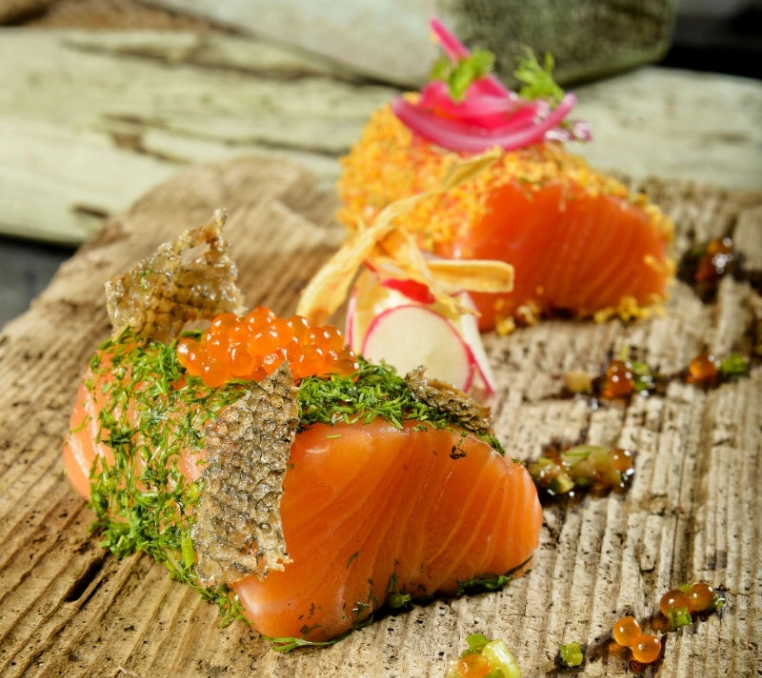Our core value
Committed to salmon
It is projected that by 2050, the global population will reach nine billion individuals, representing a significant increase of approximately one-third since the beginning of the new millennium. Given that over one billion people are presently suffering from undernourishment, the world will have to double its food production by 2050 compared to the levels of 2010 in order to satisfy the growing demand. The vast potential for this growth lies within our water resources, rather than land. Despite approximately 70 percent of the Earth’s surface being covered by water, merely a small fraction, less than five percent, of the world’s food production currently takes place in the ocean. It is no surprise, then, that we hold a strong belief in the sea as the future of sustenance.
Sustainability
When considering sustainability, salmon farming boasts an exceptionally minimal environmental impact. This characteristic positions salmon as an immensely sustainable food source, both presently and in the times to come, ensuring its availability to people worldwide.
CO2 emissions 1
Water consumption 2
Feed utilization 2
Energy 3
Protein 3
Yield 4
Yield per 100 kg of fodder 4
2,9 kg
1.400 liter
1,2 kg
27%
24%
68%
57 kg
3,4 kg
4.300 liter
2,2 kg
10%
21%
46%
21 kg
5,9 kg
6.000 liter
3,0 kg
14%
18%
52%
17 kg
30 kg
15.400 liter
4-10 kg
27%
15%
41%
4-10 kg
1 Measured in kg co2/kg edible parts at slaughter
2 Measured in kg litres/kg edible parts at slaughter
3 Measured in % how much energy from the forage remains in edible parts at slaughter
4 Measured in kg co2/kg edible parts at slaughter
Salmon is a safe food
Salmon is a safe and nutrient-rich food choice. Norwegian farmed salmon, in particular, is known for its health benefits and safety. It is a valuable protein source with essential vitamins, micronutrients, and optimal levels of omega-3 fatty acids. Scientific research confirms the positive impact of omega-3 fatty acids on cardiovascular health and brain development in children.
While all food may contain trace amounts of undesirable substances, farmed salmon undergoes rigorous monitoring and testing. Stricter specifications and improved purification technologies have led to a decreasing trend in the presence of contaminants. As a result, the risk of harm from environmental toxins associated with consuming farmed salmon is very low.


Salmon is healthy
Undesirable substances in salmon products are well below recommended limits set by Norwegian and international standards. The health benefits of consuming oily fish outweigh any potential negative effects. Norwegian guidelines recommend including oily fish in meals 2-3 times a week, with at least 200g of fish per week being oily fish. Farmed salmon is a viable and beneficial option.
Norwegian seafood undergoes comprehensive monitoring for foreign substances. The use of antibiotics in Norwegian aquaculture is rare and strictly limited. Fish welfare is prioritized, and treatment is administered only when necessary. Effective vaccines and regulations minimize the need for antibiotics. Traces of pharmaceutical residues exceeding limits have never been found in Norwegian farmed salmon.
In General
‘…Norwegian farmed salmon is a safe and nutritious choice, providing essential nutrients for a healthy diet.’
Safe fish feed
The feed provided to salmon is carefully formulated to meet their specific nutritional requirements at various life stages. Strict specifications govern the procurement of raw materials for the feed, ensuring optimal nutritional content while minimizing unwanted foreign substances. As fish farmers, we maintain full awareness of the feed composition and the origin of the raw materials used in its production. Regular checks, including oversight by the authorities, are conducted to verify the quality and composition of the feed.